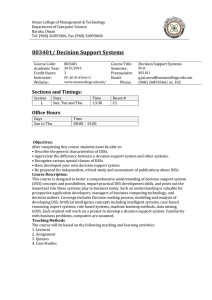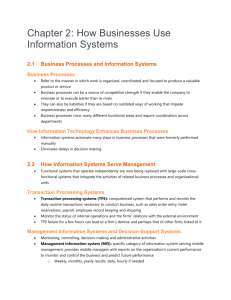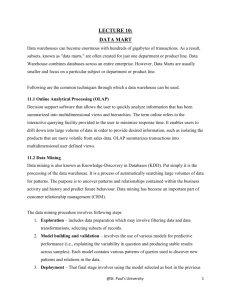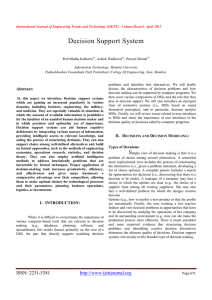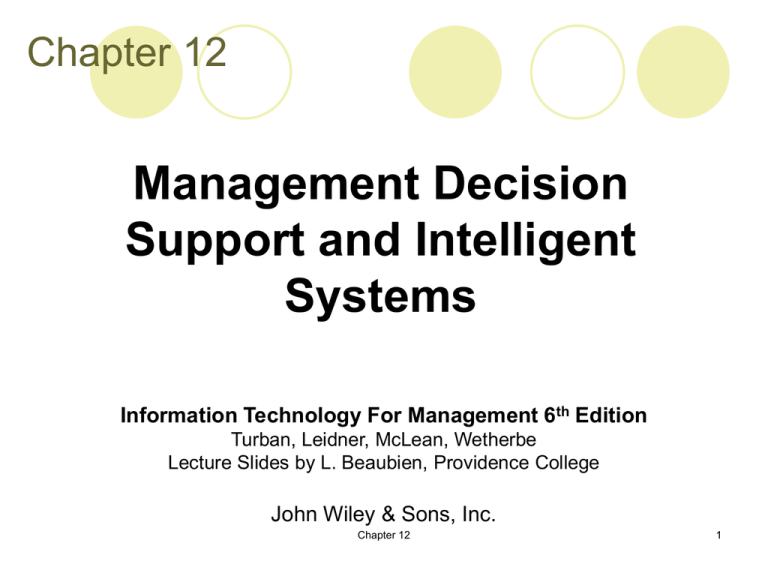
Chapter 12
Management Decision
Support and Intelligent
Systems
Information Technology For Management 6th Edition
Turban, Leidner, McLean, Wetherbe
Lecture Slides by L. Beaubien, Providence College
John Wiley & Sons, Inc.
Chapter 12
1
Learning Objectives
Describe the concepts of managerial, decision making, and
computerized support for decision making.
Justify the role of modeling and models in decision making.
Describe decision support systems (DSSs) and their
benefits, and describe the DSS structure.
Describe the support to group (including virtual) decision
making.
Describe organizational DSS and executive support
systems, and analyze their role in management support.
Describe artificial intelligence (AI) and list its benefits and
characteristics.
Chapter 12
2
Learning Objectives (Continued)
List the major commercial AI technologies
Define an expert system and its components and describe
its benefits and limitations.
Describe natural language processing and compare it to
speech understanding.
Describe Artificial Neural Networks (ANNs) and their
characteristics and major applications. Compare it to fuzzy
logic and describe its role in hybrid intelligent systems.
Describe automated decision support - advantages and
areas of application
Describe special decision support applications including the
support of frontline employees.
Chapter 12
3
Decision Process
Chapter 12
4
Decision Complexity
Chapter 12
5
Characteristics and Capabilities of
DSSs
Sensitivity analysis is the study of the impact
that changes in one (or more) parts of a model
have on other parts.
What-if analysis is the study of the impact of a
change in the assumptions (input data) on the
proposed solution.
Goal-seeking analysis is the study that
attempts to find the value of the inputs
necessary to achieve a desired level of output.
Chapter 12
6
Structure and Components of DSSs
Data management subsystem contain all the
data that flow from several sources.
Model management subsystem contains
completed models and the building blocks
necessary to develop DSS applications.
User interface covers all aspects of the
communications between a user and the DSS.
Users are the persons faced with the problem or
decision that the DSS is designed to support.
Knowledge-based subsystems provide the
required expertise for solving some aspects of
the problem.
Chapter 12
7
DSS Process
Chapter 12
8
Organizational Decision Support
System (ODSS)
Organizational Decision Support System
(ODSS) is a DSS that focuses on an
organizational task or activity involving a
sequence of operations and decision makers
and provides the following:
It affects several organizational units or corporate
problems;
It cuts across organizational functions or hierarchical
layers;
It involves computer-based and (usually)
communications technologies.
Chapter 12
9
Executive Information (Support)
Systems
Executive information system (EIS) also known as an
executive support system (ESS), is a computer-based
technology designed specifically for the information needs of
top executives and provides for:
Rapid access to timely information;
Direct access to management reports;
Very user friendly and supported by graphics.
Exception reporting – reporting of only the results that deviate
from a set of standards.
Drill down reporting – investigating information in increasing
detail.
Easily connected within online information services and e-mail.
Include analysis support, communications, office automation and
intelligence support.
Chapter 12
10
Enterprise Decision Simulator
Technology that supports the informational
needs of executives in the so-called “corporate
war room”.
Management Cockpit is a strategic management
room that enables top-level decision makers to
pilot their businesses better.
The environment encourages more efficient
management meetings and boosts team
performance via effective communication.
Chapter 12
11
Enterprise Decision Simulator
(Continued)
Key performance indicators and information
relating to critical success factors are displayed
graphically on the walls of the meeting room.
The cockpit environment is integrated with
SAP’s ERP products and reporting systems.
External information can be easily imported to
the room to allow competitive analysis.
Chapter 12
12
Intelligent Systems
Expert systems (ESs) are attempts to mimic human experts. It is decision-making
software that can reach a level of performance comparable to a human expert
in some specialized and usually narrow problem area. The idea is simple:
expertise is transferred from an expert or other source of expertise to the
computer.
The transfer of expertise from an expert to a computer and then to the user
involves four activities:
Knowledge acquisition (from experts or other sources)
Knowledge representation (organized as rules or frames in the computer)
Knowledge inferencing is performed in a component called the inference
engine of the ES and results in the recommendation.
Knowledge transfer to the user (the expert’s knowledge has been
transferred to users).
Chapter 12
13
Intelligent Systems (cont’d)
Chapter 12
14
The Benefits of Expert Systems
Benefit
Description
Increased output and productivity
ESs can configure for each custom order. Increasing production
capabilities
Increased quality
ESs can provide consistent advise and reduce error rates.
Capture and dissemination of scarce expertise
Expertise from anywhere in the world can be obtained and used.
Operation in hazardous environments
Sensors can collect information that an ES interprets, enabling
human workers to avoid hot, humid, or toxic environments.
Accessibility to knowledge and help desks
ESs can increase the productivity of help – desk employee, or even
automate this function.
Reliability
ESs do not become tired or bored, call in sick or go on strike. They
consistently pay attention to details.
Ability to work with incomplete or uncertain information
Even with answer of ‘ don’t know ‘ an ES can produce an answer,
though it may not be a definite one.
Provision of training
The explanation facility of an ES can serve as a teaching device and
knowledge base for novices.
Enhancement of decision- making and problem-solving
capabilities
ESs allow the integration of expert judgment into analysis (e.g.,
diagnosis of machine malfunction and even medical diagnosis).
Decreased decision-making time
ESs usually can make faster decision than humans working alone.
Reduce downtime
ESs can quickly diagnose faster decisions than humans and
prescribe repairs.
Chapter 12
15
Natural Language Processing &
Voice Technologies
Natural language processing (NLP): Communicating
with a computer in English or whatever language you
may speak.
Natural language understanding/speech (voice)
recognition: The ability of a computer to comprehend
instructions given in ordinary language, via the keyboard
or by voice.
Natural language generation/voice synthesis:
Technology that enables computers to produce ordinary
language, by “voice” or on the screen, so that people
can understand computers more easily.
Chapter 12
16
Neural Networks
Neural networks are a system of programs and
data structures that approximates the operation
of the human brain.
Neural networks are particularly good at
recognizing subtle, hidden, and newly emerging
patterns within complex data as well as
interpreting incomplete inputs.
Chapter 12
17
Fuzzy Logic
Fuzzy logic deals with the uncertainties by
simulating the process of human reasoning,
allowing the computer to behave less precisely
and logically than conventional computers do.
Involves decision in gray areas.
Uses creative decision-making processes.
Chapter 12
18
Simulation Systems
Simulation generally refers to a technique for conducting experiments (such as
"what-if") with a computer on a model of a management system. Because DSS
deals with semi structured or unstructured situations, it involves complex
reality, which may not be easily represented by optimization or other standard
models but can often be handled by simulation. Therefore, simulation is one of
the most frequently used tools of DSSs.
Advantages of Simulation.
Allows for inclusion of the real-life complexities of problems.
Is descriptive.
Can handle an extremely wide variation in problem types.
Can show the effect of compressing time.
Can be conducted from anywhere.
Chapter 12
19
Why Managers Need IT Support
A key to good decision making is to explore and
compare many relevant alternatives. The more
alternatives that exist, the more computerassisted search and comparisons are needed.
Typically, decisions must be made under time
pressure. Frequently it is not possible to
manually process the needed information fast
enough to be effective.
Chapter 12
20
Why Managers Need It Support
(Continued)
It is usually necessary to conduct a sophisticated
analysis in order to make a good decision. Such
analysis requires the use of modeling.
Decision makers can be in different locations
and so is the information. Bringing them all
together quickly and inexpensively may be a
difficult task.
Chapter 12
21
Managerial Issues
Cost justification, intangible benefits. While some of the benefits of
management support systems are tangible, it is difficult to put a dollar value
on the intangible benefits of many such systems.
Documenting personal DSS. Many employees develop their own DSSs to
increase their productivity and the quality of their work. It is advisable to
have an inventory of these DSSs and make certain that appropriate
documentation and security measures exist.
Security. Decision support systems may contain extremely important
information for the livelihood of organizations. Taking appropriate security
measures, especially in Web-based distributed applications, is a must.
Ready-made commercial DSSs. With the increased use of Web-based
systems and ASPs, it is possible to find more DSS applications sold off the
shelf, frequently online. The benefits of a purchased or leased DSS
application sometimes make it advisable to change business processes to
fit a commercially available DSS.
Chapter 12
22
Managerial Issues (Continued)
Intelligent DSS. Introducing intelligent agents into a DSS application can
greatly increase its functionality.
Organizational culture. The more people recognize the benefits of a DSS and
the more support is given to it by top management, the more the DSS will be
used.
Embedded technologies. Intelligent systems are expected to be embedded in
at least 20 percent of all IT applications in about 10 years. It is critical for any
prudent management to closely examine the technologies and their business
applicability.
Ethical issues. Corporations with management support systems may need to
address some serious ethical issues such as privacy and accountability.
Chapter 12
23
Chapter 12
Copyright © 2008 John Wiley & Sons, Inc. All rights reserved. Reproduction or
translation of this work beyond that permitted in Section 117 of the 1976 United
States Copyright Act without the express written permission of the copyright
owner is unlawful. Request for further information should be addressed to the
Permissions Department, John Wiley & Sons, Inc. The purchaser may make
back-up copies for his/her own use only and not for distribution or resale. The
Publisher assumes no responsibility for errors, omissions, or damages, caused
by the use of these programs or from the use of the information contained
herein.
Chapter 12
24


